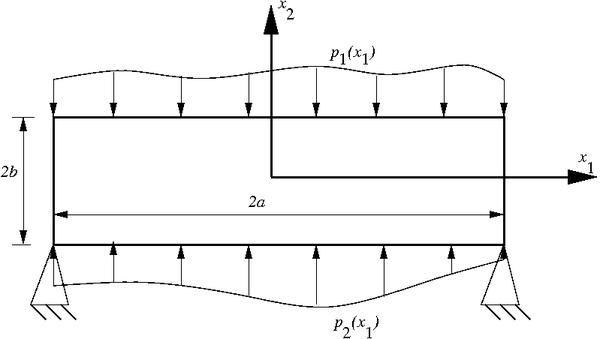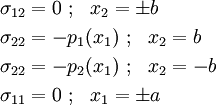Introduction to Elasticity/Fourier series solutions
< Introduction to ElasticityUsing the Airy Stress Function : Fourier Series Solutions
Useful for more general boundary conditions.
Suppose

Substitute into the biharmonic equation. Then,

or, equivalently,

The hyperbolic form allows us to take advantage of symmetry about the
 plane.
plane.
If  ,
,

Example of Fourier Series Technique
 Bending of an elastic beam on a foundation |
The traction boundary conditions are

The problem is broken up into four subproblems which are superposed. The subproblems are chosen so that the even/odd properties of hyperbolic functions can be exploited.
The loads for the four subproblems are chosen to be
![\begin{align}
f_1(x_1) = f_1(-x_1) & =
\cfrac{1}{4}\left[p_1(x_1)+p_1(-x_1)+p_2(x_1)+p_2(-x_1)\right]\\
f_2(x_1) = -f_2(-x_1) & =
\cfrac{1}{4}\left[p_1(x_1)-p_1(-x_1)+p_2(x_1)-p_2(-x_1)\right]\\
f_3(x_1) = f_3(-x_1) & =
\cfrac{1}{4}\left[p_1(x_1)+p_1(-x_1)-p_2(x_1)-p_2(-x_1)\right]\\
f_4(x_1) = -f_4(-x_1) & =
\cfrac{1}{4}\left[p_1(x_1)-p_1(-x_1)-p_2(x_1)+p_2(-x_1)\right]
\end{align}](../I/m/a5b45b299a435f959fc9157b9212f3eb.png)
The new boundary conditions are

Let us look at the subproblem with loads  applied on the top and bottom of the beam. The problem is even in
applied on the top and bottom of the beam. The problem is even in  and odd in
and odd in  .
So we use,
.
So we use,
![\begin{align}
\varphi & = \sum^{\infty}_{n=1} f_n(x_2) \cos(\lambda_n x_1) \\
& = \sum^{\infty}_{n=1} \left[A_n x_2\cosh(\lambda_n x_2)+
B_n\sinh(\lambda_n x_2)\right]\cos(\lambda_n x_1)
\end{align}](../I/m/44dcb9ec49c3d2feb0dc2f73b7b1cf1d.png)
At  ,
,

Hence  if
if  .
.
We can substitute  and express the stresses in terms of
Fourier series.
and express the stresses in terms of
Fourier series.
Applying the boundary conditions of  we get
we get
![\begin{align}
\sum^{\infty}_{n=1} \left[A_n \lambda_n \cosh(\lambda_n b)+
A_n \lambda_n^2 b \sinh(\lambda_n b)+
B_n \lambda_n^2 \cosh(\lambda_n b)\right]\sin(\lambda_n x_1) & = 0\\
\sum^{\infty}_{n=1} \left[A_n \lambda_n^2 b \cosh(\lambda_n b)+
B_n \lambda_n^2 \sinh(\lambda_n b)\right]\cos(\lambda_n x_1) & = f_3(x_1)
\end{align}](../I/m/47aefdb6ade7611442fc019cd598deaf.png)
The first equation is satisfied if

Integrate the second equation from  to
to  after multiplying by
after multiplying by  .
.
All the odd functions are zero, except the
case where  .
.
Therefore, all that remains is
![\left[A_m \lambda_m^2 b \cosh(\lambda_m b)+
B_m \lambda_m^2 \sinh(\lambda_m b)\right] a =
\int_{-a}^{a} f_3(x_1) \cos(\lambda_m x_1) dx_1 \qquad (2)](../I/m/bb8a4af222939f01b1f9c29955f5e348.png)
We can calculate  and
and  from equations (1) and (2), substitute them into the expressions for stress to get the solution.
from equations (1) and (2), substitute them into the expressions for stress to get the solution.
We do the same thing for the other subproblems.
The Fourier series approach is particularly useful if we have discontinuous or point loads.